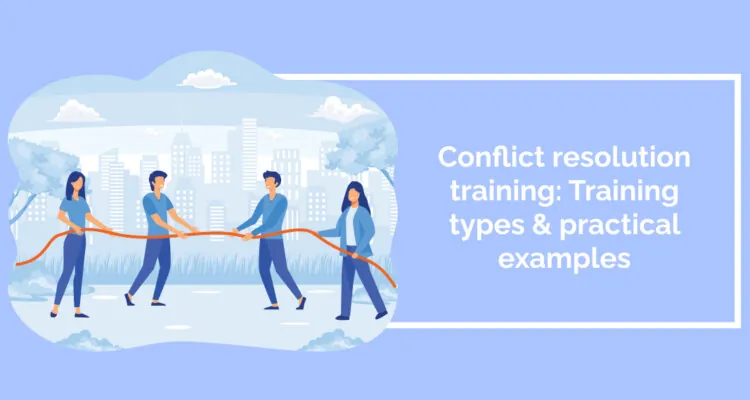
Conflict in any situation involves some of the most unmanageable human emotions: fear, anger, arrogance, vulnerability, pride, and much more besides. That’s why even the smallest incidences of conflict – negative feedback, ignored suggestions, or minor political differences – can have a significant impact on the performance of individuals, teams, and organizations.
With so much at stake, leaders can’t assume that their staff will sort out their problems naturally. Every organization should make sure that they have staff who can manage conflict resolution effectively.
If you’re struggling to make this work, a program of conflict resolution training is the best way to move forward. This article will get you started with what you need to know about this aspect of learning and development. It will:
- Define “conflict resolution training” clearly;
- Introduce the ways that you can handle conflict resolution training;
- Examine several situations where conflict resolution training is especially likely to be useful.
By the end of the article, you should have a clearer idea of how to navigate the challenges of training for conflict. We will mention some of the wider theoretical and strategic challenges of organizational conflict, but our focus throughout will be on how to enhance skills in this area.
What is conflict resolution training?
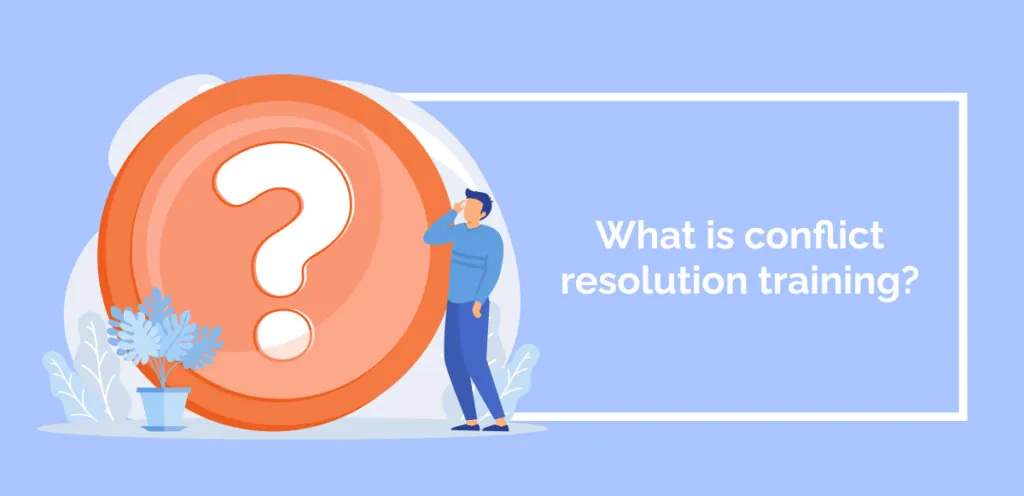
Conflict resolution training is a program designed to teach individuals the skills and techniques necessary to effectively manage and resolve conflicts.
Conflict can be a major organizational problem: causing delays, friction, and resignations. Many conflicts cannot be resolved with natural “soft skills”, and need the more advanced techniques of conflict management. That’s where conflict resolution training comes in.
This training gives employees everything they need to manage and resolve conflicts efficiently, avoiding the costly problems that tension creates. There are many aspects of conflict resolution, all of which require specific training pathways. However, employees who go through conflict resolution training will at a bare minimum get:
- Knowledge of how conflict works, in theory and practice;
- A choice of strategies about how to resolve conflict;
- To practice real-life skills in handling conflict.
We will see in the next section how different types of conflict resolution training use these features differently.
Every member of an organization can benefit from learning conflict management techniques. Senior executives should be especially well-trained in conflict resolution. But team members, line management, customer-facing roles, and any employee who engages with others can use training in conflict management techniques to catch problems before they become serious.
The different aspects of conflict resolution training
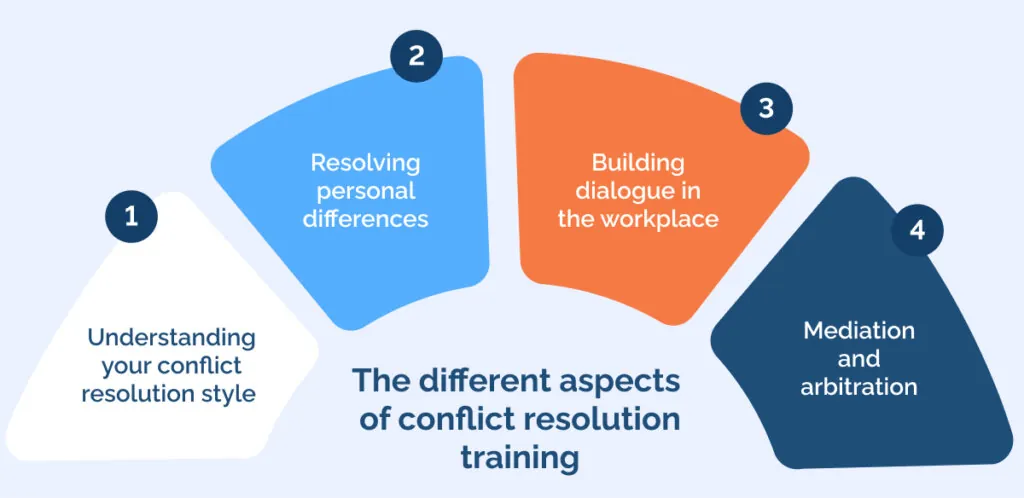
This section will consider different aspects of learning and development in conflict management. In particular, we’ll think about:
- Understanding your conflict resolution style
- Resolving personal differences
- Building dialogue in the workplace
- Mediation and arbitration
A comprehensive training program might touch on these different aspects of conflict management. But many times, you will facilitate piecemeal instruction for your staff members or leadership, in which case you’ll need to prioritize the most important features.
This kind of training will be especially valuable for staff in HR departments, but staff at all levels of the company can benefit from training in conflict management.
As we go through these aspects of teaching conflict management, we’ll mention some of the employee training methods that make them work. After all, resolving conflicts takes a balance of theoretical, practical, and emotional intelligence – which requires different pedagogical approaches to be successful.
Understanding your conflict management style
Understanding your conflict management style involves reflecting on your natural tendencies and preferences. It helps employees recognize their strengths and limitations.
This awareness is valuable in personal and professional contexts, enabling individuals to adapt their approach based on the nature of the conflict and the desired outcomes.
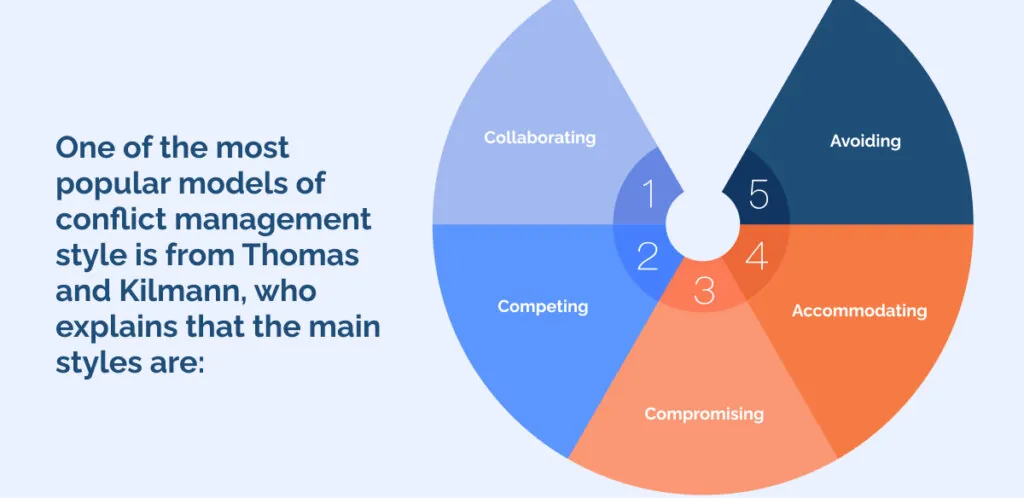
One of the most popular models of conflict management style is from Thomas and Kilmann, who explains that the main styles are:
- Collaborating
- Competing
- Compromising
- Accommodating
- Avoiding
There are strengths and weaknesses in all of these approaches. Effective conflict resolution training encourages individuals to not only understand their own styles but also appreciate the diversity of styles within a team or organization, fostering a collaborative and constructive approach to conflict resolution.
How to implement it
Understanding your conflict management style requires education and reflection. Any training program for conflict style will need to give opportunities for participants to think about their own experiences in relation to the theory of conflict styles.
Some of the prime training methods include:
- Journaling. Encourage employees to maintain conflict resolution journals, reflecting on their experiences, emotions, and the strategies they employ in various conflict situations. Journaling prompts self-reflection and deepens understanding.
- Informal learning communities. Some of the knowledge about conflict style could be shared through conversations between staff members at similar managerial levels. If a member of HR can establish informal learning communities, employees can come together to share their insights and experiences related to conflict management.
- Use an online assessment tool. The Thomas-Kilmann Conflict Mode Instrument is one easy way to deliver this kind of training. It provides all the tools you need to reflect on a leader’s conflict style: although as a third-party provision, this assessment is an additional cost.
Tips and techniques for success
While you’re planning an intervention about conflict management styles, you could also think about the following pointers:
- This aspect of conflict management is not just for executives – it’s a great starting point for anyone. So don’t be afraid of helping more employees understand themselves, and how they fit into a bigger structure of conflict.
- Learning about conflict styles will be most effective with a range of learning methods. Role-play and simulation can offer excellent ways to consider alternative ways to handle conflict.
Resolving personal differences
Personal differences sound like a minor matter, but they can make a huge impact on employee wellbeing and team productivity.

Examples of this type of conflict can arise from any of the following issues:
- Values
- Beliefs
- Personality traits
- Work styles
- Interests
- Habits
- Perspectives
And many more besides.
Participants in this type of training learn effective communication strategies, active listening, and techniques tailored to address disagreements, misunderstandings, and differing perspectives. The goal is to empower individuals with the tools needed to foster healthier relationships, build understanding, and promote constructive dialogue in their personal lives.
How to implement it
A good program for resolving personal differences should take a multi-pronged approach, engaging policy, leadership, and specific training sessions. Some of the implementation strategies can include the following :
- Create clear guidelines on your company lines on divisive issues. Make sure that line managers are fully briefed.
- Using the company-wide guidelines, conduct training sessions on generic conflict resolution techniques – especially soft skills in listening, compromise, and empathy.
- Incorporate training on cultural competence to address personal differences stemming from diverse cultural backgrounds. Foster an understanding of different values, norms, and communication styles to promote a more inclusive work environment.
- Offer continual updates on your program. It may be especially important around specific times of year – such as elections, religious holidays, sporting events. Short updates emphasize that this kind of conflict requires continuous learning from across the organization.
Tips and techniques for success
In this age of diversity, equality, and inclusion, people are more willing than ever to resolve conflicts around personal differences. However strategies in this area are also prone to challenges. Think about the following additional tips:
- Some companies talk a lot about settling personal differences. But if your leaders aren’t invested in these changes, and your corporate actions don’t match the training, employees will see it as nothing more than talk. The tolerance and inclusivity of your internal messaging should be in line with your wider business practices: this is a challenge for many companies.
- Ongoing monitoring can be important. You can’t prevent problems before they happen. If your executive hierarchy can pick up on the latest news, trends, and problems, you have the chance to stop problems at an early stage.
- Follow-up support is a good investment of time. Continued mentoring or access to resources can reinforce the principles learned in isolated conflict management training sessions.
Building dialogue within a workplace
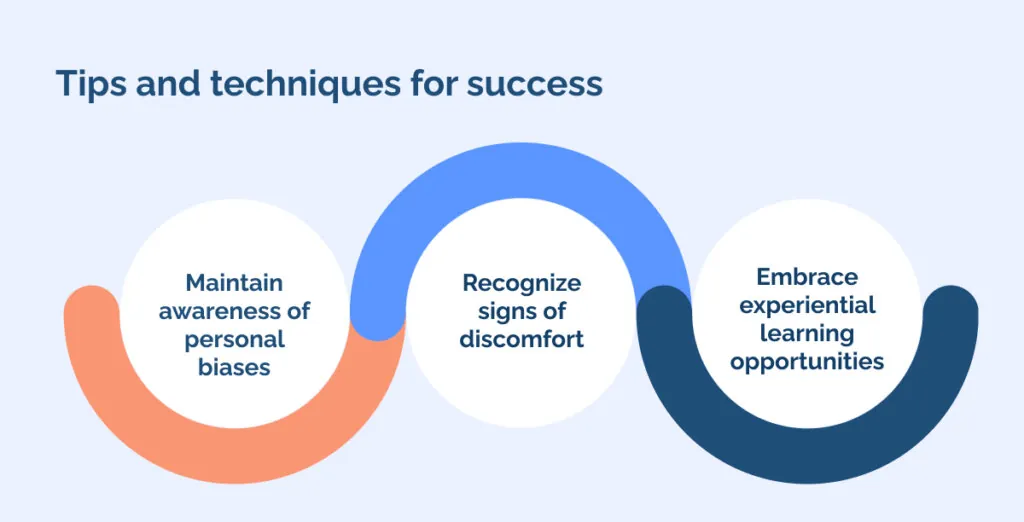
Supporting your staff to build better dialogue supports deeper improvements to your organizational culture. Effective dialogue can be a vital tool in mediating conflicts. But it is also a preventative method, helping staff to avoid conflicts before they even arise.
Unlike conventional debates, where opposing sides seek to overpower each other, dialogue operates on “agreeing to agree.” In dialogue, participants collaboratively work towards developing a common understanding, actively listening to find commonality and greater comprehension.
Not everyone can see the opportunities to build more effective dialogues in the workplace. Training in this area, for staff at all levels of the organizational hierarchy, can have many excellent benefits.
How to implement it

There are many ways you can train for better dialogue. These steps could help you get started:
- Provide staff with a foundational framework for conducting meaningful dialogues. This includes emphasizing active listening, encouraging open and honest communication, and fostering an environment where diverse perspectives are valued.
- Clarify the role of a facilitator. Offer insights into the distinct roles within a dialogue, delineating the responsibilities of facilitators and participants. Empower facilitators to guide discussions effectively, and educate participants on the importance of constructive engagement and active contribution.
- Set ground rules and foster mutual respect. Highlight the significance of establishing clear ground rules for dialogues. These rules should promote a safe and inclusive space for communication, emphasizing mutual respect and ensuring that every participant feels heard. Training should equip staff with the skills to create and maintain a conducive dialogue environment.
Tips and techniques for success
Facilitating dialogue can be difficult because it requires a lot of sensitivity to hard-to-spot human feelings and emotions. Think about these extra tips to make your dialogue training work better:
- Maintain awareness of personal biases. Facilitators must actively seek self-awareness regarding their own personal and emotional stances in a situation. While it’s natural to hold opinions, it’s crucial not to let these opinions unduly influence the trajectory of the conversation. A facilitator’s neutrality fosters an open and inclusive dialogue space.
- Recognize signs of discomfort. A key skill for facilitators is the ability to discern when speakers may feel uneasy or when their boundaries are being challenged. Sensitivity to non-verbal cues and subtle shifts in demeanor helps facilitators create an environment where participants feel secure and respected.
- Embrace experiential learning opportunities. Building effective facilitation skills often requires hands-on experience. Engaging in interactive workshops, participating in role-playing exercises, and receiving constructive feedback through observation and evaluation are invaluable methods for skill development. These approaches offer a safe and supportive environment for honing the nuanced art of facilitating dialogue.
There’s no substitute for experience when people are trying to build these skills. But interactive workshops, role-play, observation, and evaluation can all be good ways to build skills safely.
Mediation and arbitration
Mediation and arbitration are specific types of conflict resolution, characterized by the presence of a 3rd party facilitator.
Mediation is a voluntary and informal process where a neutral third party, known as the mediator, assists in disputing parties in reaching a mutually acceptable resolution. Arbitration is a more formal process in which an impartial third party, the arbitrator, hears arguments and evidence from each side and makes a binding decision to resolve the dispute.
Good training in this area requires attention to a lot of core skills, including:
- A wide range of soft skills – including active listening, cultural sensitivity, respect, and empathy
- Knowledge of the ethical implications
- Clarity around company policy
- An up-to-date understanding of relevant legal issues involved.
Mediation and arbitration can, however, take a range of forms. For settling minor disputes within a department, a mediator only needs to be a sensitive listener.
How to implement it
Mediation and arbitration training is a niche specialism. If you believe your company would benefit from trained mediators, consider the following steps:
- Make sure you undertake a needs assessment. Not every company needs the skills of an in-house mediator: it may be cheaper and more effective to employ outside help when serious needs arise.
- For your training program, many third-party consultancies offer off-the-rack programs – lasting a few hours, a week, or more. In some specialist cases, you may wish to develop your comprehensive curriculum. It must cover essential topics such as conflict analysis, communication skills, legal principles, and ethical considerations.
- Make use of practical exercises alongside any instructional or reflective learning. Integrate practical exercises, case studies, role-playing, and simulations to allow participants to apply theoretical knowledge in realistic scenarios. This hands-on approach enhances retention and skill development.
Tips and techniques for success
There’s always room to improve on your mediation training strategy. Think about the following tips to build a successful program:
- There are plenty of resources out there to help leaders understand the role of mediation. Look at the suggested reading from CIPD to see more.
- Emphasize the importance of continuous learning in the field of mediation and arbitration. Stay updated on evolving legal frameworks, industry best practices, and new techniques. Encourage participants to engage in further education and training to enhance their expertise over time.
The practical business applications of conflict resolution training
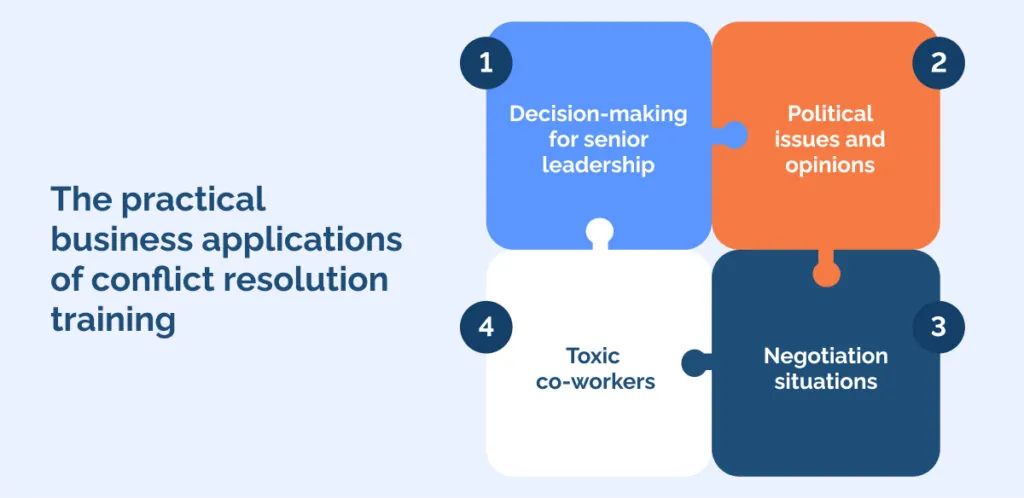
In this section, we will take a closer look at four situations that can particularly benefit from lessons in conflict resolution. They are:
- Decision-making for senior leadership
- Political issues and opinions
- Negotiation situations
- Toxic co-workers.
These areas show us an overview of how conflict resolution training can be so valuable to any large company.
Decision-making for senior leadership
For people in senior leadership positions, conflict should not only be resolved, it should create even better solutions. When everyone in the team has an opinion, conflict will be inevitable – when choosing a strategy, when corralling experience and knowledge, and when delegating. In these cases, the ways that a leader responds to their team is extremely important.
For more insights into ways senior leaders can handle conflict to their advantage, Gartner’s Tina Nunno has a unique perspective.
Political issues and opinions
Inter-employee conflict is one of the key trends to manage in 2024, according to Gartner’s Future of Work trends report. From our selection of conflict resolution training methods, you can particularly learn from techniques in building dialogue and resolving personal differences.
Experts in the field recognize that there are some simple but effective ways of improving training in this area. As Rebecca Knight explained in a 2020 HBR article, some approaches you can take include:
- Model inclusivity and listening
- Don’t avoid political discussions
- Establish ground rules and etiquette
- React with clarity to inappropriate comments
In the right organizational culture, such steps become clear on their own. But additional training may help to get them in place to improve working life for everyone.
Negotiation situations
In high-stakes negotiation, small conflicts can have very serious consequences. A conflict that would be easy enough to manage if it was internal can become extremely costly. Your company might end up taking a serious financial hit when it would be far easier to make amends on a personal level.
To train for this eventuality, consider adding some of the following strategies:
- Ensure that conflict resolution training is part of your negotiating teams’ skillset. Don’t wait for the problems to happen to make a change.
- Negotiators should also have an advanced level of domain-specific knowledge. They could get that knowledge through extensive briefings if they are not already a trained expert in the field. This knowledge will help them to identify problems early on and resolve conflicts before they become insurmountable.
- Use real-world case studies of negotiations that involve conflicts. Analyzing past negotiations provides valuable insights into the dynamics of conflicts, the strategies employed, and the outcomes. Discussing these cases encourages critical thinking and helps negotiators understand the varied approaches to conflict resolution.
Toxic co-workers
Toxicity is subjective. But any employee knows that there are managers who constantly irritate others. It may not be about personal values, politics, or anything material. But through personalities, attitudes, and priorities, your team may get dragged down by some bad apples.
It’s difficult to train for this type of conflict management because toxicity is so hard to spot – and even harder to challenge. When conflicts arise, it’s confusing for everyone. As always, it’s best to resolve these issues at the earliest possible stage. After all, challenging co-worker attitudes can lead to all kinds of complaints – informal and formal alike.
Training strategies to deal with this include:
- A team that’s well-versed in building dialogue and resolving personal difficulties will have fewer problems with toxic individuals. If people can air their views openly and without confrontation, they will make progress.
- However, getting some reading and education about the problem can be useful. Get to know the “five jerks at work” (as Tessa Watt calls them) to predict the situations as they arise.
- In these challenging situations, a third-party mediator can be invaluable. They don’t need to be a fully qualified mediator, but their understanding of mediation processes will take them a long way (and ideally, avoid a formal complaint).
Conflict will happen (so get ready to manage it)
Conflict in the workplace is, sadly, inevitable. Even with managers who have the best of intentions for their team, people will annoy, upset, and criticize one another.
That’s why conflict resolution training is so important. It’s unwise to trust that arguments will resolve themselves.
But if you’re at the start of your conflict resolution journey, just remember that training is just one part of the jigsaw. As 2021 Guidance from the UK’s CIPD suggests – “employers should aim to strengthen social cohesion throughout their organizations more generally, to make conflict less likely in the first place”.
Conflict resolution training is most useful when your business is investing in organizational culture from the ground up.
WalkMe Team
WalkMe spearheaded the Digital Adoption Platform (DAP) for associations to use the maximum capacity of their advanced resources. Utilizing man-made consciousness, AI, and context-oriented direction, WalkMe adds a powerful UI layer to raise the computerized proficiency, everything being equal.



